by J.S. Tissainayagam, Stanley Center for Peace & Security, Iowa, USA, May 17, 2021
Ranjini,* a housewife, lives in Kilinochchi, a town in Sri Lanka’s Tamil-majority Northern Province. Earlier this year, the government began vaccinating the public against COVID-19. But this has made her fearful: she is not sure if she will be injected with vaccine to suppress the virus or, instead, a poison that might kill her.
Ranjini’s apprehension is based on allegations of poisoning in 2016 by former Tamil combatants of the Liberation Tigers of Tamil Eelam (LTTE) who fought for secession before being defeated in May 2009. The rebellion was motivated by Tamils accusing the country’s numerically larger group—the Sinhalese—of discrimination and human rights violations against them. The story of poisoning surfaced when Tamil politicians alleged that over 100 ex-combatants had died after they were injected with poison during a postwar rehabilitation program run by the military, a claim that was fervently denied by the government. Although the accusations of poisoning were never verified by government medical professionals, the unknown cause of the deaths have continued to be a source of upset among Tamils distrustful of the Sri Lankan government.
Tamil distrust of the COVID-19 vaccination program is caused by other factors too. In 2014, Sri Lankan media reported that around 50 women had been forcibly sterilized with hormonal contraceptive inserts at the Kilinochchi Hospital. A pregnant woman died of an infection contacted during the procedure.
“Ex-LTTE fighters live in Kilinochchi, and I know some of them are not what they were before. They get sick like those who died of the injections,” says Ranjini. “Although anti-coronavirus vaccines are administered mainly by civilian health workers and not the military, I fear taking the jab because the vaccination program is run by the Sinhala government.”
President Rejects International Accountability
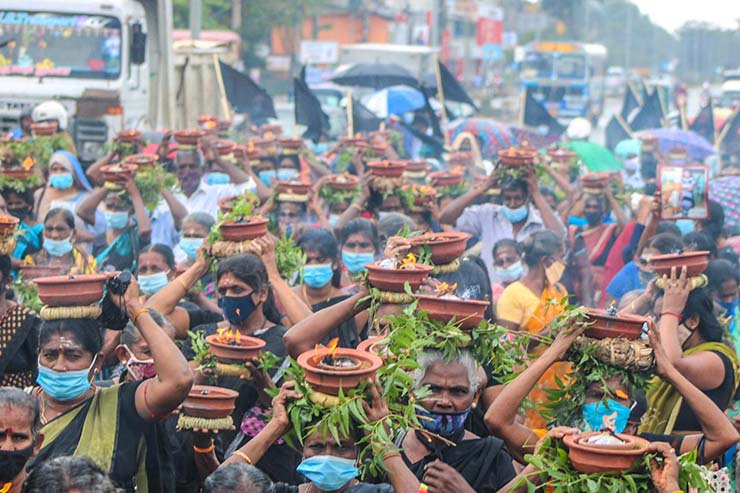
CREDIT: Tamil Guardian. Security forces in the Northern and Eastern Provinces of Sri Lanka continue to commit atrocity crimes such as enforced disappearances and torture. Here, mothers and fathers protest the disappearance of children by placing pots with burning coals on their heads as a sign of commitment.
Following the end of the Sri Lankan civil war in 2009, rather than advancing a political settlement, successive governments have tried to pacify the Northern and Eastern Provinces where Tamils live in significant numbers by saturating it with the predominantly Sinhala-Buddhist military. The security forces continue to commit atrocity crimes such as enforced disappearances and torture.
Post-civil war governments have also refused to hold the military accountable for wartime atrocities despite a United Nations report citing credible evidence that government forces and the LTTE committed war crimes and crimes against humanity.
The United Nations Human Rights Council (UNHRC) challenged Sri Lanka’s lackadaisical approach to accountability by adopting Resolution 30/1 in 2015, a recommendation that urged the country to rescind counterterror legislation, criminalize enforced disappearances, and implement a judicial mechanism with foreign judges to try war criminals.
Among those accused of wartime atrocities is Gotabaya Rajapaksa, who was Sri Lanka’s defense secretary and widely credited with crushing the LTTE. But due to successive governments lacking the political will to implement the UNHRC resolution, he escaped punishment. In November 2019, Rajapaksa was elected Sri Lanka’s president.
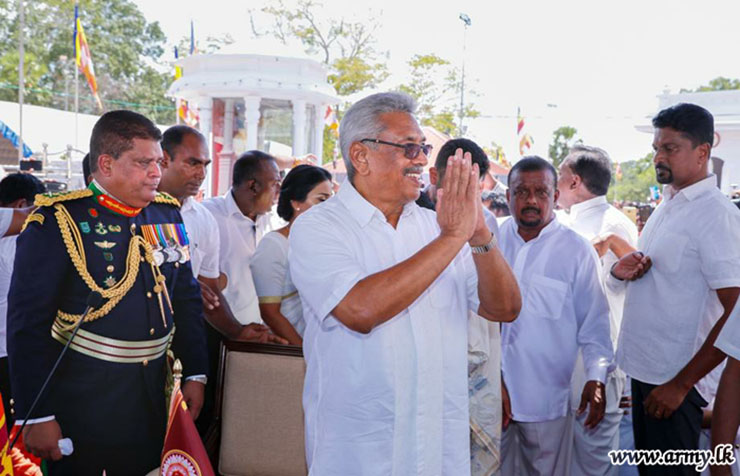
CREDIT: Tamil Guardian. Among those accused of wartime atrocities are President Gotabaya Rajapaksa (right) and the head of the COVID-19 prevention task force in Sri Lanka, Army Commander Shavendra Silva.
Five months later, Rajapaksa withdrew his government’s commitment from implementing the UNHRC resolution in favor of a “domestically designed and executed” reconciliation process. Atrocity survivors and human rights activists are certain this promise will not be fulfilled.
Alex Bellamy, an expert on atrocity crimes, says, “One of the principal sources of risk for future mass atrocities is the recent past of atrocity crimes.” Where recent atrocity crimes have been committed, he says, and no effective peacebuilding measures address their source, or seek truth, justice, and reparations, there could be a recurrence.
Uptick of Military Surveillance
Leela,* who also lives in Kilinochchi and works for a nongovernmental organization, suspects that the military is using the COVID-19 pandemic to spy on Tamil civilians. This, she says, is a step toward future rights violations.
“The police came to our home claiming to investigate if there were coronavirus patients. But from their questions it was obvious they wanted other information,” she says.
The police searching for information were part of the government’s plan for a militarized response to the pandemic. As the virus spread in March 2020, Rajapaksa appointed another alleged war criminal, Lieutenant General Shavendra Silva, the current army commander, as the head of the COVID-19 prevention task force. In February 2020, Silva was designated and sanctioned by the US State Department for gross violations of human rights, including extrajudicial killings.
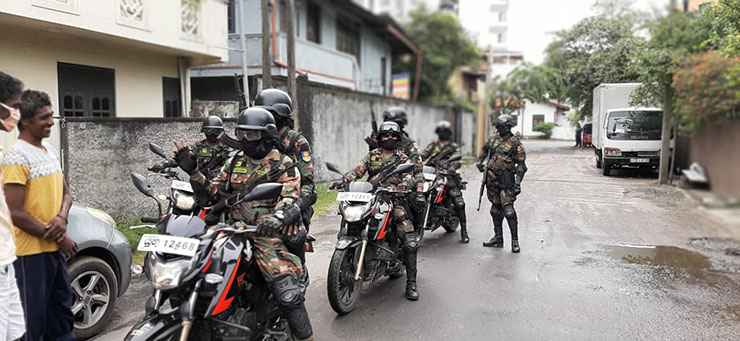
CREDIT: Tamil Guardian Since March 2020, the Sri Lankan government has mobilized the military as well as police and the state’s intelligence service for door-to-door contact tracing of coronavirus patients. Some suspect the military is using contact tracing as a means to spy on Tamil civilians.
Banning Burials Affects Muslims
In April 2020, the government mandated that people who had died of COVID-19 be cremated. The order strongly impacted Muslims, whose religious practices require burial of their dead. Muslims felt the government was forcing them to act against their beliefs. The regime cited health experts’ warning that burying those who die of the coronavirus could contaminate groundwater and spread the disease. Although UN experts contradicted the government’s claim, the government refused to yield.
Muslims have been consistent targets of Sinhala-Buddhist abuse since 2009. Early assaults were against Muslim culture. Later, Buddhist monks packaged fear of Muslims as an existential threat, demonizing them as conspiring to overrun Sinhala-Buddhists and rule the country. This incitement led to riots in 2014 and 2018 where Muslims were killed.
On Easter Sunday 2019, Muslim extremists attacked three churches and upscale hotels, killing over 250 people, allegedly inspired by ISIS, or the so-called Islamic State of Iraq and al-Sham. Armed military rounded up Muslims in security sweeps, entering mosques, businesses, and homes. Sinhala mobs attacked Muslim villages, and Muslim women were told not to wear the hijab and niqab.
Against this fraught background, the Rajapaksa government’s insistence on cremating the dead led to international condemnation and demands the order be rescinded. A 20-day-old infant who allegedly died of COVID-19 and was cremated by a hospital without parental consent, brought out the tragic consequences of the government’s regulations in very personal ways.
On February 26, 2021, Sri Lanka abruptly reversed the policy, allowing the resumption of burials, and land has now been approved for that purpose. However, the new regulations stipulate that government officers should do a test to determine if the body is COVID-19 positive, in which case the body must be buried in government-approved sites. Since Muslim practice is to finish the burial within 24 hours of the death, completing tests within that timeframe is a challenge.
As a result, many Sinhala bureaucrats demand bribes from families of the deceased to cut red tape and release the body within 24 hours. So although cremations are no longer mandatory, Muslims fear racist Sinhala officers can obstruct conducting last rites on time.
“Death remains a source of double anguish now: the passing away of a relative and trying to clear the body for burial. Earlier it was triple—the pain of cremation,” says Nizam,* a Sri Lankan Muslim journalist and researcher.
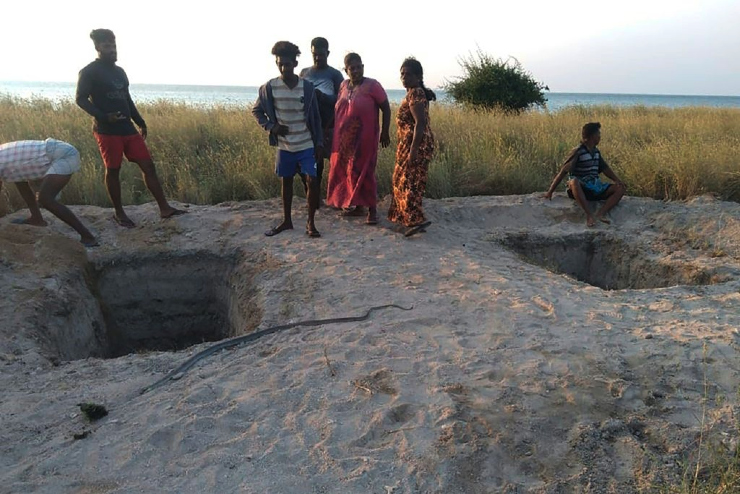
CREDIT: AFP via Getty Images. Authorities have dug graves to bury COVID-19 victims after the government reversed its internationally-condemned policy of forced cremations of deceased Muslims. Although cremations are no longer mandatory, some Muslims believe Sinhala officers deliberately obstruct conducting last rites on time.
Tamils and Muslims Defy Government
But while the government’s response to the pandemic has raised the specter of recurring atrocities, there has also been resilience. Initially, when the government unleashed intrusive military-based responses, it caught people like Leela off guard. But then resistance kicked in.
Tamils commemorate those who died in the civil war—Maaveerar Naal (Great Heroes’ Day)—on November 27. The government has tried to block the event since the civil war ended. Last Great Hero’s Day, the police obtained restraining orders from magistrates to limit public gatherings, citing the pandemic restrictions in place throughout the country. But the court orders did not ban private memorialization. Although Tamils respected court orders and mostly refrained from public mourning, they rebuked the police and military when they attempted to stop private ceremonies as well.
The most robust act of defiance of the government’s use of the coronavirus to suppress freedom of expression was P2P, a march organized by Tamil and Muslim activists in February 2021 to protest the government’s refusal to prosecute perpetrators of mass atrocities against Tamils and insistence that Muslims cremate their dead. Its success showed the potential that Tamil-Muslim unity could have as a disruptive force and likely played a role in Sri Lanka reversing the ban on Muslim burials. While there is resilience, the government continues to detain and harass those who took part in the P2P march, citing COVID restrictions, while allowing rallies for causes that benefit Sinhala protestors.
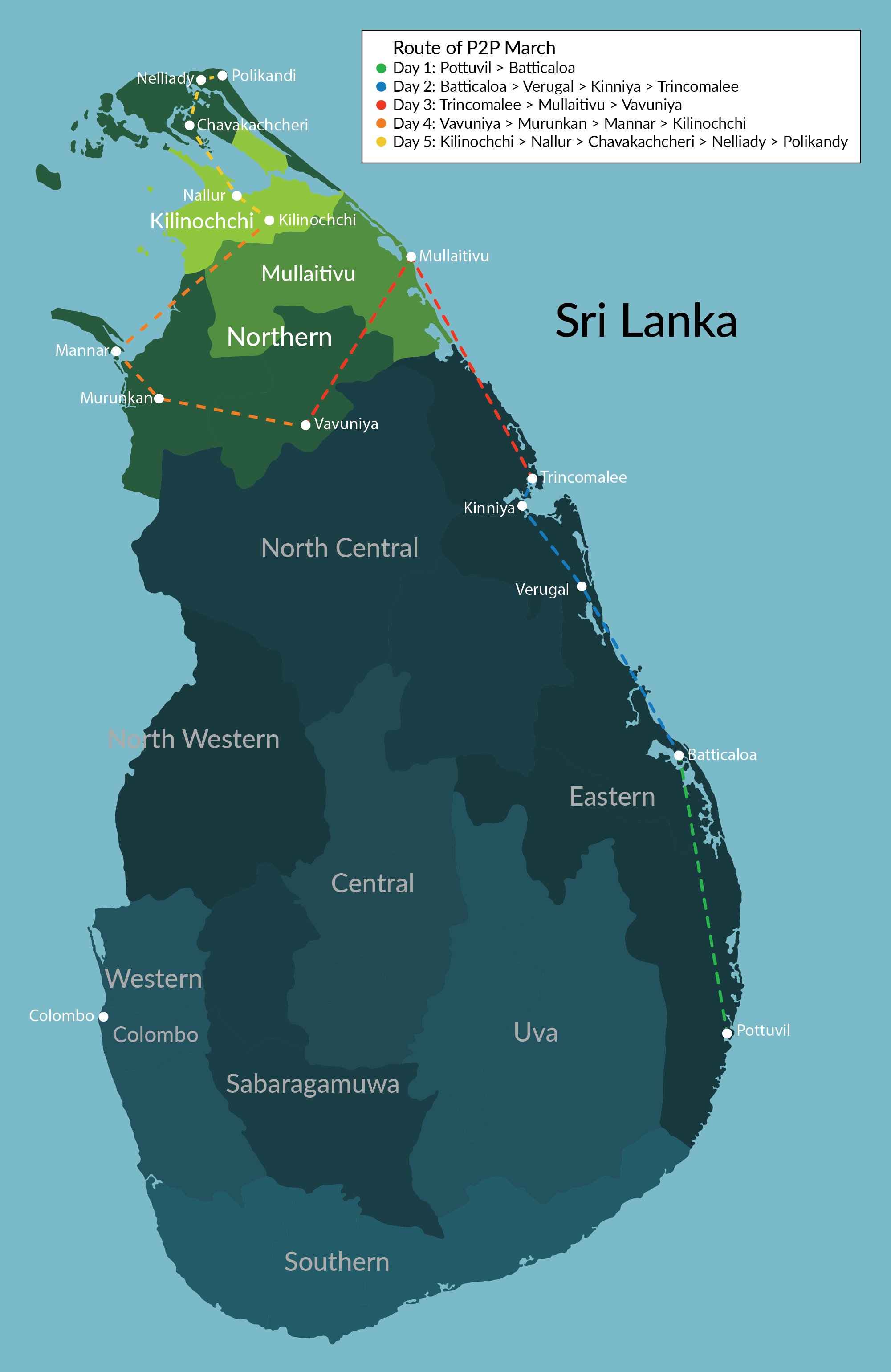
CREDIT: Stanley Center The most robust act of defiance of the Sri Lankan government’s use of the coronavirus to suppress freedoms was P2P, a march organized by Tamil and Muslim activists in February 2021. The P2P march route is shown here.
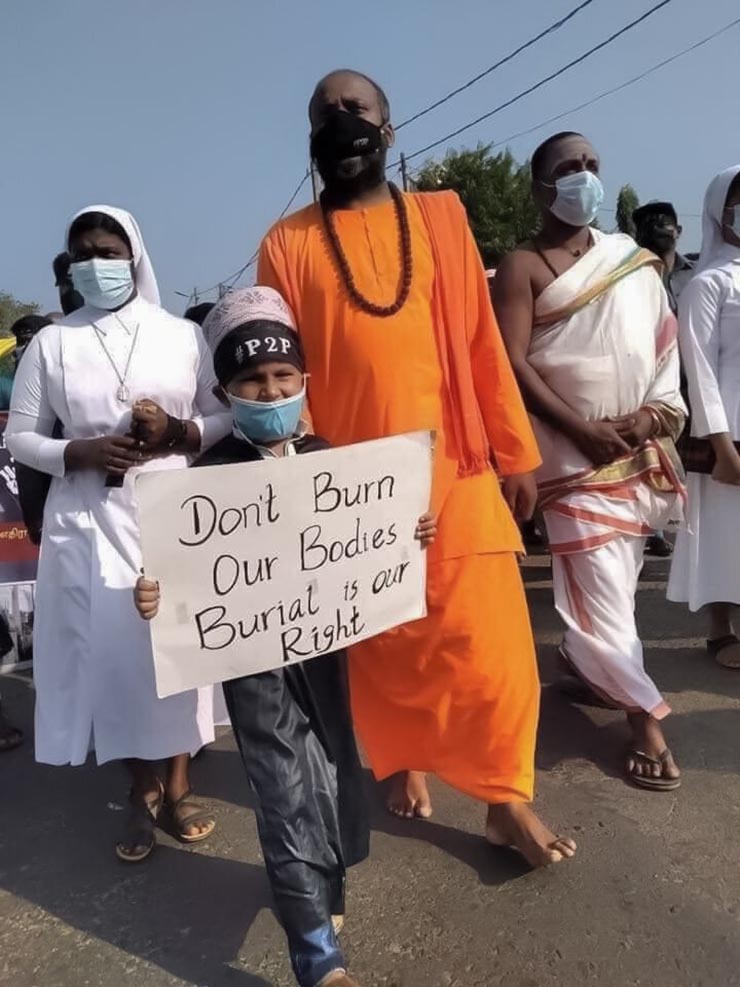
CREDIT: Tamil Guardian While the government continues to detain and harass those who took part, the P2P march’s success showed the potential that Tamil-Muslim unity could have as a disruptive force.
Also in February, stories began circulating of the coronavirus spreading in garment factories in Mullaitivu in the Tamil-majority north. There was a tussle between the management, which wanted the factories to remain open despite the health risk, and the workers, who, fearing the pandemic, preferred taking pay cuts and remaining home. On February 22, three buses arrived in the villages of Manikapuram, Valluvarpuram, and Ilangopuram in Mullaitivu to herd reluctant workers to the factories.
As the matter grew confrontational, the villagers, used to protesting disappearances, mobilized. Over 500 people—mostly young men—blocked the streets to prevent the buses from leaving. Typical to the militarized north, army and police personnel and the garment-factory management descended on the villages. As they tried to force the issue, the crowd grew visibly angrier.
“When they realized how they were outnumbered, the managers, police, and army [personnel] fled. They fear crowds,” says Ramani,* an eyewitness.
The response by Sri Lankans, especially Tamils and Muslims, to the government’s methods to control COVID-19 reflect what the United Nations calls “widespread mistrust in state institutions among different groups as a result of impunity.” It is a risk factor for genocide, war crimes, or crimes against humanity. The government’s handling of the response has pushed Sri Lanka further down the path of high-risk countries, and another catastrophic event could trigger atrocity crimes. Meanwhile, only mass resistance in whatever scale can check a government well on the path to dictatorship.
* Names marked with an asterisk have been changed to protect people’s identity and safety.